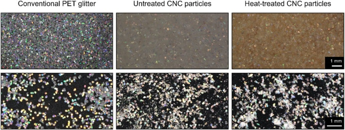A new type of glitter is safe for soil-dwelling organisms.
Researchers are concerned about the impact of "microplastics" — small plastic particles less than five millimeters in size — on living organisms. Microplastics can originate from glitter or arise from the breakdown of larger items, such as plastic bottles, into increasingly smaller particles in the environment.
Glitter is a widely used type of microplastic found in clothing, cosmetics, and decorative applications. Most glitter is made from a plastic known as polyethylene terephthalate, or PET. This same plastic is used to make water and soft drink bottles. Traditional glitter often contains aluminum or other metals that give it its shine.
Although biodegradable glitter is already available on the market, previous studies show that it can be just as harmful, if not more toxic, to aquatic organisms than traditional PET glitter. Most biodegradable options are coated with a colored aluminum layer and a thin layer of another plastic, which still leads to environmental pollution.
Researchers from Australia and the UK are working on creating more eco-friendly glitter. Scientists have developed new glitter made from nanocrystals of cellulose. It sparkles in the light, contains no plastics or metals, and is biodegradable. The study was published in the journal Chemosphere.

Cellulose is made from glucose and gives wood its strength. The researchers compared the potential toxicity of traditional glitter with the new cellulose-based glitter and assessed the sustainability of the new product.
To observe the effects on living organisms, they selected the springtail (Folsomia candida). These small, white, eyeless invertebrates are widespread in soils worldwide, feeding on fallen leaves and compost. Springtails are often used as indicators of soil quality, as they are sensitive to toxic substances.
The researchers subjected the springtails to various concentrations of traditional and cellulose-based glitter and studied the effects on reproduction, survival, and growth of soil organisms.
The experiments showed that neither type of glitter affected the survival or size of the springtails. However, when the concentration of traditional glitter in the soil reached 1000 milligrams per kilogram of soil, the reproduction rate of these organisms dropped by 61 percent. The new cellulose glitter did not have any toxic effects on the reproduction of springtails at any concentration.
This level of pollution is comparable to soils containing microplastics. Contaminated soils have been found to contain up to 100,000 milligrams of microplastics per kilogram, while in most soils this figure does not exceed 10,000 milligrams per kilogram. Thus, a tenth of the minimum pollution significantly affects soil inhabitants.
A decrease in the springtail population could lead to a deterioration of soil health: less organic matter will decompose, and fewer nutrients will be available for plants.
Researchers recommend thinking twice before using traditional glitter in makeup, clothing, or decorative projects. They are working on developing a safer, eco-friendly, and equally sparkling alternative.